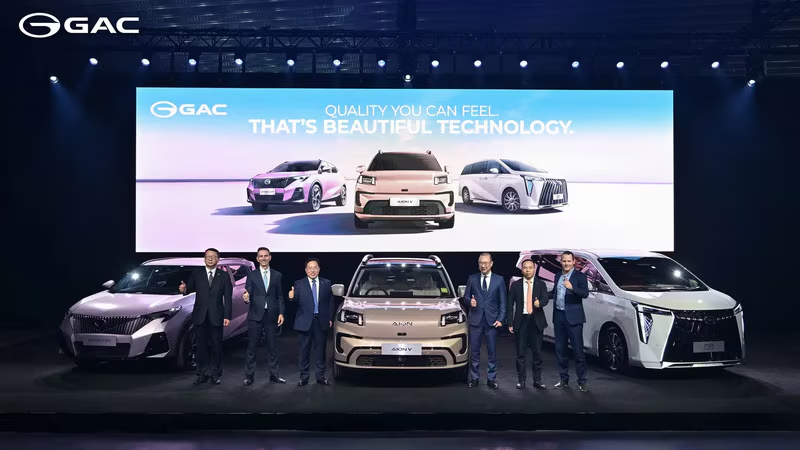
The Chinese automaker GAC Group is making waves. From launching multiple electric vehicle models to entering new markets with entire strategies, the company is clearly stepping up its global game. Whether you’re into EVs, international market strategy or automotive trends, GAC’s latest moves are worth paying attention to. Here’s what’s going on, why it matters, and what to watch moving forward.
GAC Group (Guangzhou Automobile Group) is a major Chinese automobile manufacturer based in Guangzhou, Guangdong. Wikipedia+1 They operate several brands—main entries include Aion (EV-focused), Trumpchi (domestic/Chinese market), and GAC Motor (export branding) among others. With production and global aspirations, the firm has been rapidly expanding beyond China.
GAC has just formally launched in Australia, with three new vehicle models and a local strategy to build a benchmark market in the region. Newswire+1 This debut is more than product release—it signals a structural commitment to a new market.
In Brazil, GAC debuted five new cars at once: four pure electric vehicles and one hybrid. GAC Group This complements GAC’s ambition to expand global footprint and meet growing EV demand.
GAC also announced a major appearance at AUTO SHANGHAI 2025, where it will debut several new vehicle models and showcase AI innovations. Gasgoo
For a company that has long been China-centric, these debuts represent a pivot to a broader international presence. Entering markets like Australia and Brazil means new demographics, regulations, competition— and big potential.
These launches are timed with rising EV interest globally. Whether in Brazil’s growth phase or Australia’s evolving market, GAC is positioning itself with electric/hybrid vehicles tailored for those regions.
Rather than simply “selling a car”, GAC’s moves show strategy: localised launches, market-specific models, full brand strategy rather than simply export. The Australia launch emphasises a local strategy, not just shipping cars.
By combining new models with AI innovations (as noted at Auto Shanghai), GAC is aligning with future-tech narratives—electric vehicles, smart systems, automated driving. This helps the brand compete not just on price but on features.
Here are some standout elements of how GAC is executing its debuts:
Simultaneous model launches: In Brazil, GAC launched five new models at once (four EVs + one hybrid) rather than one model at a time. GAC Group
Local strategy and brand foundation: In Australia, the launch wasn’t just cars—it was a “local strategy” with branding, market build-out and regional focus. Newswire+1
Tech focus and global ambition: At major shows GAC announced AI-driven innovations alongside models, signalling capability beyond just manufacturing. Gasgoo
Pricing and affordability: In China, GAC’s Aion i60 (extended-range / hybrid) is positioned at a competitive price (~104,800 yuan) as part of its overseas growth strategy. Caixin Global
No major expansion is without risk. If you’re tracking GAC’s global debuts, keep the following in mind:
Brand recognition & trust: In new markets, GAC is relatively lesser-known compared with legacy brands. Building trust (service network, reliability, resale value) takes time.
Local regulations & infrastructure: EVs depend on charging infrastructure, market incentives, local policy. What works in China may need adaptation elsewhere.
Competition & market saturation: In markets like Australia or Brazil, many automakers and EV brands are vying for attention. GAC needs differentiation.
Logistics & localisation: Import vs local manufacturing, supply chain resilience, tariffs—all influence cost, pricing and profit margins.
After-sales, support & network: To succeed overseas, GAC must build local dealer networks, parts supply and customer support—these often make or break new market entries.
Consumers in new markets: More choices—especially EV/hybrid choices—from brands like GAC may push prices down, accelerate innovation.
Automotive industry watchers: An example of a Chinese automaker going global—valuable for trend analysis, strategy modelling.
Competitor brands: Legacy automakers will need to watch how GAC competes (pricing, features, localisation) and adapt.
Investors / supply-chain players: GAC’s global supply, localisation plans, partnerships, tech stack may open business / investment opportunities.
GAC Group’s recent debuts are more than product launches—they’re strategic moves signalling global ambition. From Australia to Brazil, from EVs to hybrids, from tech demonstration to full market strategy—GAC is stepping into new territories with intent.
If you’re watching the auto industry, this is a company worth keeping tabs on. Whether it succeeds will depend not just on the cars, but on how well it delivers on service, local relevance, and customer trust in new markets. But the direction is clear: GAC is going global—and with force.